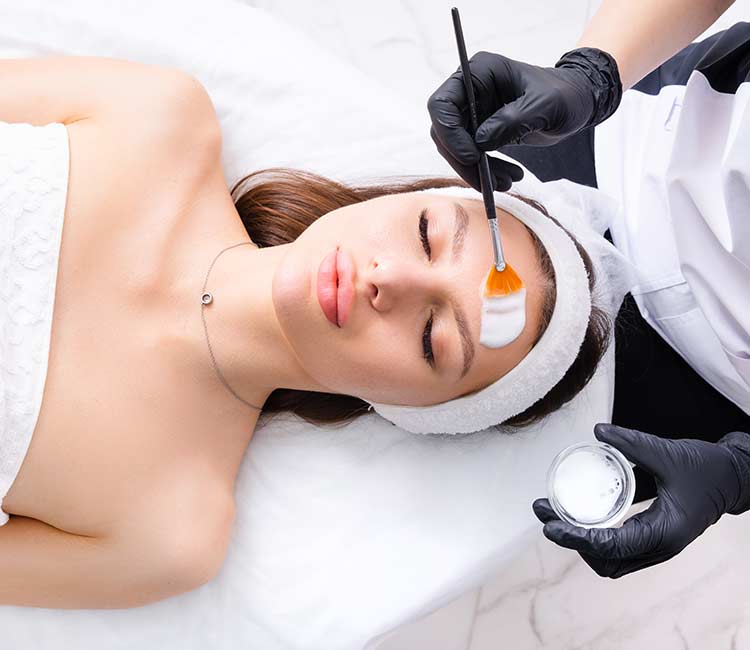A peel is an aesthetic medical procedure that involves applying a chemical solution to the skin to exfoliate and remove dead cells from the superficial, medium, or deep layers of the epidermis. This process stimulates cell renewal, improves the overall appearance of the skin, and helps treat a variety of skin issues, including excess sebum, enlarged pores, and imperfections commonly associated with oily skin.
Oily skin is a common concern for many people, characterised by an overproduction of sebum that can lead to shine, enlarged pores, and a higher tendency to develop imperfections such as acne. To restore a more matte,
smooth, and blemish-free complexion, peels for oily skin are becoming an increasingly popular aesthetic solution. They address issues specifically related to excess sebum, improve skin texture, and regulate sebum production.

Oily skin is generally caused by an overproduction of sebum by the sebaceous glands. This excess sebum can clog pores and lead to the formation of comedones (blackheads) and blemishes. Additionally, oily skin often appears uneven and dull.
A peel for oily skin helps to :
• Remove dead skin cells : the build-up of dead cells can worsen oily skin issues. By removing them, the peel unclogs pores and reduces the formation of comedones.
• Reduce excess sebum : chemical peels help regulate sebum production, which is essential for preventing excessive shine and breakouts.
• Refine skin texture : peels stimulate cell renewal, leading to smoother and more even skin. Pores appear visibly tighter after a series of treatments.
• Reduce imperfections and acne scars : medium to deep peels are particularly effective for treating acne scars, a common issue for those with oily skin.
Oily skin is characterised by an overproduction of sebum by the sebaceous glands. This excess sebum gives the skin a shiny appearance, especially in the T-zone (forehead, nose, and chin), and can make pores appear more visible and enlarged. People with oily skin are often prone to imperfections such as blackheads, pimples, or acne, since the excess sebum tends to clog the pores.
Although oily skin can be difficult to manage, it also has the advantage of being more resistant to the signs of ageing, thanks to its better natural hydration.
Caring for oily skin requires a suitable skincare routine to control excess sebum without causing irritation. It is essential to cleanse the skin daily with a gentle, soap-free cleanser to remove impurities and excess sebum without damaging the skin barrier.
Using an astringent toner containing salicylic acid or glycolic acid helps tighten the pores and regulate sebum production. Then, it is important to moisturise the skin with a light, non-comedogenic cream suitable for oily skin. Finally, daily sun protection is crucial to prevent UV-induced damage – a mattifying formula should be preferred to avoid increasing shine.
Complementary treatments such as clay masks or chemical peels are key for controlling imperfections and improving skin texture.

The main benefits of a peel for oily skin include :
• Reduction of excess sebum : one of the key advantages of a peel is the reduction in sebum production. By exfoliating the skin, the peel removes impurities and dead cells that contribute to the build-up of sebum in the pores. This helps mattify the skin and reduce long-term shine.
• Minimised enlarged pores : enlarged pores are a common concern for oily skin. Peels help tighten the pores, giving the skin a more even and smoother appearance. By reducing pore size, peels also help prevent blackheads and blemishes.
• Improved skin texture : peels promote cell renewal, helping to smooth the skin’s texture. After a peel, the skin appears softer, smoother, and more radiant, with fewer irregularities.
• Treatment of acne scars : acne scars are among the most difficult issues to treat in oily skin. Peels – especially medium and deep peels – are highly effective in reducing the appearance of acne scars.
• More radiant complexion : oily skin can often appear dull due to the build-up of dead skin cells. Peels remove this superficial layer, revealing the fresher, more luminous skin underneath.
Several types of chemical peels are adapted for oily skin, each with its own characteristics and indications.
Salicylic acid is a beta-hydroxy acid (BHA) well known for its effectiveness on oily and acne-prone skin. Due to its solubility in the lipid film, it easily penetrates clogged pores and dissolves excess sebum as well as dead skin cells.
Benefits : salicylic acid is especially recommended for oily skin because it helps unclog pores, reduce inflammation, and prevent the appearance of new blemishes.
Indications : this type of peel is ideal for individuals with enlarged pores, blackheads, and mild breakouts.
Glycolic acid, an alpha-hydroxy acid (AHA), is commonly used in superficial peels. While it is primarily recognised for its exfoliating properties, it also helps regulate sebum production and improves skin texture.
Benefits : glycolic acid removes dead surface cells and promotes cell turnover, which helps reduce shine and refine skin texture.
Indications : suitable for oily skin with rough texture, this peel is ideal for those seeking immediate radiance and a smoother complexion.
TCA is an acid used in medium peels to deep peels. It is recommended for individuals with more difficult-to-treat skin concerns such as acne scars, pigmentation spots, or wrinkles. It also helps tighten the pores.
Benefits : TCA treats deeper imperfections and stimulates cell regeneration. It is especially effective on oily skin with more significant skin damage.
Indications : this peel is often used for oily skin with deep acne scars or severe blemishes.
The Jessner peel is a combination of salicylic acid, lactic acid, and resorcinol. This versatile formula is ideal for addressing multiple skin concerns, including acne, enlarged pores, and excess sebum.
Benefits : the Jessner peel penetrates deeply, cleanses the pores, stimulates cell renewal, and reduces dark spots.
Indications : it is recommended for individuals with oily skin, moderate acne, or uneven texture.

After a peel for oily skin, it is normal to experience a few temporary side effects, such as redness, a feeling of tightness, or mild flaking. These effects generally disappear after a few days. To speed up healing, it is recommended to :
• Hydrate the skin : after a peel, the skin may become slightly dry. It is advised to use a moisturizer suitable for oily skin to promote healing without weighing the skin down.
• Use sun protection : the skin can be more sensitive to the sun after a peel. It is essential to apply sunscreen with SPF 50 to protect it from UV rays and prevent hyperpigmentation.
• Avoid harsh products : during the healing period, avoid products containing irritating actives, such as retinoids or mechanical exfoliants, which could damage the skin.
The number of peel sessions needed depends on the severity of the skin issues and the type of peel used. In general, for optimal results on oily skin, 3 to 6 sessions are recommended, spaced 4 to 6 weeks apart. Doctor Romano will advise you on the exact number of sessions based on your specific needs.
The peel designed for oily skin is offered at a rate of 200 CHF per session at Dr. Romano’s clinic in Geneva. This treatment helps regulate sebum production, refine skin texture, and prevent the appearance of blemishes.
The number of sessions varies depending on the skin’s needs, its evolution during treatment, and the goals defined during the consultation. The price per session remains fixed, regardless of the frequency or duration of the protocol implemented.
For oily skin, a salicylic acid peel is the most recommended. This lipophilic acid penetrates deep into the pores, regulates sebum production, and reduces breakouts. Glycolic and lactic acid peels can also be used to refine skin texture and stimulate cell renewal.
Utilisez un nettoyant doux formulé pour peaux grasses, contenant des actifs purifiants comme l’acide salicylique ou le zinc. Nettoyez le visage matin et soir pour éliminer l’excès de sébum et les impuretés. Une fois par semaine, optez pour un masque à l’argile pour désincruster les pores en profondeur.
Exfoliez votre peau avec un gommage doux à grains fins ou un exfoliant chimique à base d’acides (AHA ou BHA). L’acide salicylique est particulièrement efficace pour désobstruer les pores et limiter l’apparition des imperfections. Évitez les gommages trop abrasifs qui peuvent stimuler la production de sébum.
• Use purifying toners with zinc or salicylic acid.
• Apply clay-based masks once or twice a week.
• Choose non-comedogenic, mattifying moisturizers.
• Avoid overly rich products and favor lightweight textures.
• Maintain a balanced diet and limit high-sugar and high-fat foods.
Pour les peaux grasses, un gommage une à deux fois par semaine est suffisant. Un excès d’exfoliation peut agresser la peau et stimuler la production de sébum. Optez pour des exfoliants doux et adaptés pour préserver l’équilibre cutané.